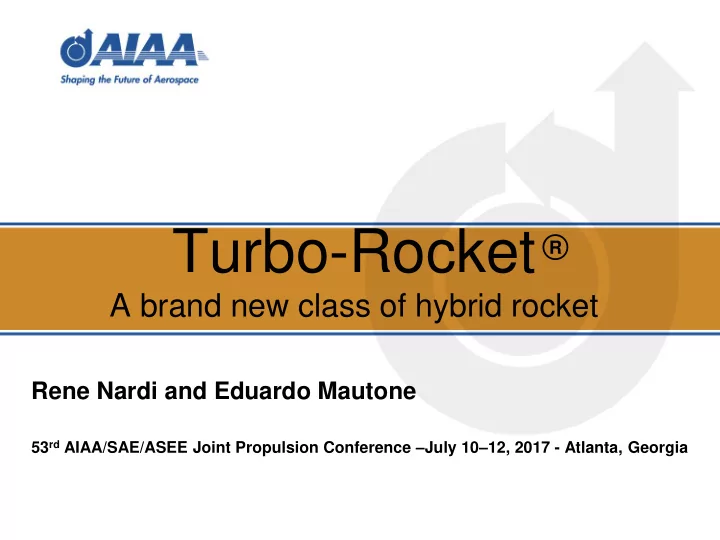

Turbo-Rocket R A brand new class of hybrid rocket Rene Nardi and Eduardo Mautone 53 rd AIAA/SAE/ASEE Joint Propulsion Conference – July 10 – 12, 2017 - Atlanta, Georgia
R Rumo ao Espaço - UFC Team 2
Background • Using liquid propellants rockets for educational purpose has proven elusive for a very long time. • Academic rocketry relies mostly on solid propellants, in part to avoid the complexity of liquid propellants rockets. • As long as the operation is restricted to the lower limits of the atmosphere, airbreathing is an option worthing further investigation. 3
Atmosphere Layers 5 km Turbo Rocket 4 National Center for Atmospheric Research
Why a liquid-gas hybrid ? The rocket should fly high enough to justify the efforts, but it may not have to leave the atmosphere. High subsonic speed is desirable, however, this rocket may not necessarily go supersonic. Jet engines are far simpler, safer and less expensive to operate than rockets. No cryogenic system to deal with: no liquid oxygen, no helium, no high pressure vessels. 5
Why a liquid-gas hybrid ? TurboRocket System LRE System
The TurboRocket is a brand new class of flying machine It does not operate as a jet aircraft, neither does it like a regular rocket. JET AIRCRAFT TURBO-ROCKET Horizontal take off Near vertical take off Flies at the horizontal position Flies on the vertical At the same altitude Always changing altitude At constant speed Always changing velocity Engine power set to idle Engine at full power (cruise) 7
The TurboRocket is a brand new class of flying machine It does not operate as a jet aircraft, neither does it like a regular rocket . ROCKET TURBO-ROCKET Carries its working fluid in the Carries its own fuel, but relies on form of fuel and oxidizer. the surrounding atmosphere as the source of oxygen. It is capable of operating within or Operation limited to the confines outside the atmosphere. of the lower atmosphere. Thrust is not affected, much, by an Noticeable thrust reduction as increase in altitude. function of altitude. High propellant mass fraction Low propellant mass fraction 8 ( 80 %) ( 5 % )
The TurboRocket is a brand new class of flying machine 9
High Level Requirements • Design, build and launch a flying machine, • To carry a 1 kg payload to 5 km ASL, • Using a comerciall off-the-shelf turbojet engine, • COTS electronics and sensors, • With a composite structure (carbon fiber). 10
Turbo-Rocket – overview 11
Turbo-Rocket in Details Nose Cone Fuselage Parachute Fins Engine Cowling Payload Flight Computer Fuel Tank Electronic Engine Control Unit 12 Engine
A Turbojet Engine ➢ Total Weight of 2,6 kg for a Maximum Thrust of 300 N, ➢ Nice thrust to weight ratio of 11:1 ➢ Liquid Rocket Engine at 30:1 ➢ Burning kerosene at a mass rate of 13 g/sec , ➢ Specific Fuel Consumption of 1.6 lb/lbf.s ➢ Liquid Rocket Engine at 10 lb/lbf.s . 13
A Turbojet Engine Jet-Cat 300 14
Engine Installation in Details Engine Installation Fuel Tank Installation 15
Performance simulations: Methodology ➢ Flight path divided into 3 portions 1 - Powered flight; 2 – Coasting; 3 - Descent 16
Performance simulations - Euler’s Method ➢ 1 - Powered flight; ➢ Find the theoretical velocity and altitude increment, without drag, over a small interval of time. ➢ Add this theoretical increment to the velocity in the last interval and determine the drag. ➢ The drag is them substituted back into the original force equation and the actual velocity increment computed from the equation thus generated. 17
Performance simulations - restrictions 18
Performance simulations: Equations 19
Performance with 1 kg payload Altitude (m) Speed (m/s) 240 6000 200 5000 160 4000 Altitude ( m ) Speed ( m/s ) 120 3000 80 2000 40 1000 0 0 0 5 10 15 20 25 30 35 40 45 Fligth time (sec) 20
Performance simulations - results 21
Specific Requirements I Altitude: 10,000 ft ( 3 km) Payload: 8.8 lb ( 4 kg ) Class: COTS Hybrid (liquid – gas) 22
Spaceport America and IREC Y(t) Altitude (m) V (t) Speed (m/s) 4000 160 150 m/s 3500 140 3000 120 Altitude (m) 2500 100 2000 80 1500 60 1000 40 Powered Flight Coasting 500 20 0 0 0 5 10 15 20 25 30 35 Flight Time ( s ) 23
What’s next ? • Incremental steps designed to improve the concept and to, eventually, enhance performance. 1. Aerospike for a supersonic nozzle 2. Air intake design optimization to reduce drag 3. Afterburning, for higher speed and altitude 4. Thrust vectoring 5. Vertical landing 24
QUESTIONS ? Rene Nardi renenardi@hotmail.com +1 912 405 6453 +55 12 98251 8864 Thank you.
Recommend
More recommend